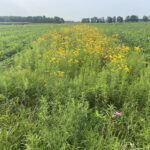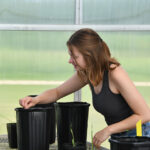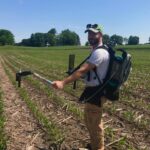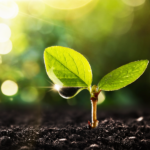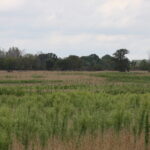East Lansing, MI – Prairie strips planted into row crops have the potential to contribute a suite of ecosystem services, such as improved soil health, water quality, and wildlife habitat. When it comes to implementation, farmers have to weigh these environmental benefits as well as the economic cost of taking land out of production. In a new study, released online by Land Economics, Michigan State University (MSU) researchers find that 20% of corn and soybean farmers in the Eastern Corn Belt are willing to convert 5% of their largest corn-soybean fields to prairie strips if paid the same
Scaling-up conservation practices: How much can farmers afford?
Measuring and predicting soil carbon to offset climate change
KBS Long-Term Ecological Research scientists awarded a $3.4 million grant from the U.S. Department of Agriculture’s Farm Service Agency to study possible climate outcomes. When an unproductive swath of farmland is planted with row crops, it results in environmental damage with little to no yield. Instead, farmers can cultivate native plants in those spaces that improve soil health and support other native species. The USDA Conservation Reserve Program, or CRP, offers them financial incentives to do just that. Measuring soil carbon for improved soil health Now, Michigan State
Studying climate change effects on plant traits: Reflections from an LTER Fellow
Graduate researcher, Kara Dobson, is a Ph.D. student in Dr. Phoebe Zarnetske’s Spatial and Community Ecology (SpaCE) Lab at Michigan State University. Her research focus is on the effects of climate warming and rainfall variability on plant traits. Climate change poses a looming threat to the functioning of ecosystems worldwide. Within ecosystems, my interest lies with plants and how they respond to stress caused by climate change. The way plants respond to stress varies widely and is dependent on things such as trait differences between plant species, differences in geographic location
Global warming impacts of intensively managed agricultural landscapes in SW Michigan: Reflections from an LTER Fellow
Graduate researcher, Pietro Sciusco, is a Ph.D. candidate in the Landscape Ecology and Ecosystem Science-LEES Lab at Michigan State University. His research interest is to estimate ecological processes and their contribution to climate change in highly managed agricultural landscapes in southwestern Michigan. This is primarily through satellite data (i.e., multi-source imaging, optical and radar) and ground measurements. There is strong scientific evidence that human activities, such as burning fossil fuels and industrial processes, are the major driver of climate change since the
My Spartan Summer: Creating drought conditions
The KBS LTER is featured in MSU Today's "My Spartan Summer". Original story, by Beth Brauer, can be found here. For more than 30 years, W.K. Kellogg Biological Station, located between Kalamazoo and Battle Creek, has been part of the national Long-Term Ecological Research network, where MSU researchers have studied the effects of land use intensity in agricultural landscapes on yield, soil health, food webs and more. Led by MSU professor and principal investigator Nick Haddad, the MSU Kellogg Biological Research Station’s Long-Term Ecological Research team has
Kellogg Biological Station joins multi-state effort to increase the adoption of prairie strips across the Midwest
Before there were the gently rolling hills of farmland and forest we see today, southwest Michigan’s landscape included large areas of prairie habitat. Dominated by wildflowers, grasses, and sedges, these habitats were maintained by periodic fires and included oak barrens, dry sand prairies, and wetland prairies. Today, only a few remnants of Michigan’s historical prairies remain on the landscape. Prairie strips, a conservation practice in row crops that protects soil and water while providing habitat for wildlife, are one way to restore these habitats to the
Are zebra mussels eating or helping toxic algae?
Long-term studies from the Kellogg Biological Station LTER reveal a surprising relationship. The original story, written by Emilie Lorditch, can be found on MSU Today. While invasive zebra mussels consume small plant-like organisms called phytoplankton, Michigan State University researchers discovered during a long-term study that zebra mussels can actually increase Microcystis, a type of phytoplankton known as “blue-green algae” or cyanobacteria, that forms harmful floating blooms. “Microcystis literally means small cell, but numerous cells cluster together in colonies that can
Insects, big data and a passion for open science launch a rewarding career
Christie Bahlai shares how her entomology research and connections made as an MSU postdoc have contributed to work honored with a National Science Foundation early-career award. Postdoctoral researchers are critical contributors to Michigan State University’s (MSU) research, bringing experience and often fresh insight. Christie Bahlai, an assistant professor at Kent State University, was recently selected for a National Science Foundation (NSF) early-career award. Bahlai, a computational ecologist, earned degrees at the University of Guelph before joining University Distinguished
Organic field day to be hosted at KBS
Please join Herbruck's on Thursday, July 8, 2021 from 8:00 a.m. - 2:00 p.m. for an Organic Field Day, hosted at the Kellogg Biological Station, 9702 N 40th St., Hickory Corners, Michigan. With over 500 certified organic farms in Michigan - and more in transition - organic production is an important aspect of Michigan agriculture. Organic practices can aid in creating resilient farming systems by successfully implementing cover crops, building soil health, planting green, and more. Information about the latest organic research and technology, alongside conversations with organic
Herbicide resistant weeds threaten conservation agriculture
East Lansing, MI – Soybean farmers are turning away from conservation agriculture practices that protect soil and environmental health to manage herbicide resistant weeds, say researchers in Michigan State University’s (MSU) Department of Agricultural, Food, and Resource Economics (AFRE). In a new study published in the American Journal of Agricultural Economics, Braeden Van Deynze (now a postdoctoral research associate at the University of Washington), Scott Swinton (MSU), and David Hennessy (MSU), examined the herbicide and tillage records of thousands of soybean farmers across the United
- « Previous Page
- 1
- 2
- 3
- 4
- 5
- 6
- …
- 17
- Next Page »
